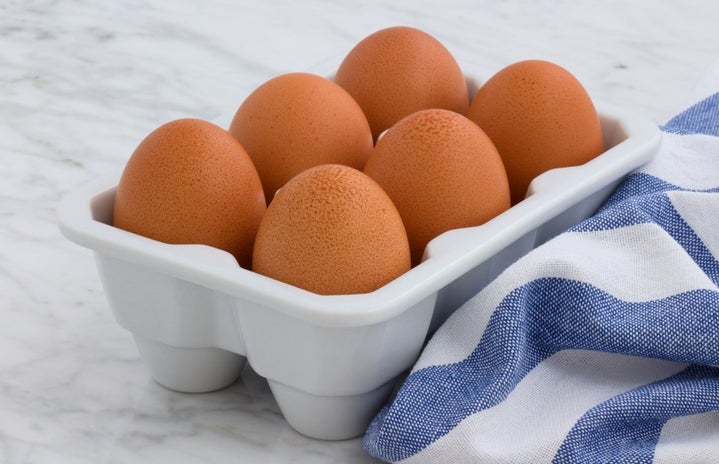When most people are strolling through the grocery store and see the “cage-free” label plastered onto a carton of eggs, they usually start to imagine chickens raised in an almost perfect environment. I used to picture a handful of animals running across a thick, grassy field. The conditions were exactly the same as the ones they would have if they lived freely in the wild, with the only differences being that they were closed off by a fence and got food daily from a feeder. But this is not even close to the reality of how these critters live. Once I learned this, I began to stop purchasing these products. Below are reasons I no longer buy eggs with this designation pasted onto them.
1. the chickens are still trapped
USDA standards for cage-free eggs require that chickens be in an indoor house, have the ability to move around, exhibit natural behaviors and get fed. This, in theory, sounds great, but there is nothing defining the minimum amount of room farms have to provide each animal with, nor does it say what features the indoor house must possess. This means companies can easily crowd chickens into a completely dark and filthy room with no AC, sunlight, windows or room to move more than a few centimeters, which is very common. Most housing venues do not even give enough room for the chickens to open up their wings or turn their bodies, which is clearly abusive to these creatures and gives them an inferior quality of life. In fact, most of them are too weak to even stand by the time they reach the slaughterhouse, since standing is a privilege they were not given in their housing due to a lack of space. This leads me to question whether the chickens truly live better quality lives than those living their lives in cages. At least those kept in coops have the ability to turn around. It should also be noted that there is no requirement for the chickens to have access to the outdoors; the USDA defines that as free-range. “Free-range” is not much better than cage-free since it is basically the same living situation, but the chickens have access to a few feet of fenced-in land that they don’t even have room to walk towards.
2. Cage-Free Does Not Mean Cruelty-Free
When I see the cage-free label, I try to remember that people who work at farms producing these eggs are no better than those working at any other company. They still underfeed their animals so they get the bare minimum amount of energy to stay alive, which often leads to the chickens trying to eat each other and sometimes succeeding. Employees kick and step on the animals when entering the houses, which they would not be able to do in a standard farm where chickens are kept more organized and there is a set space for workers to walk around. Employees also do not clean the housing facilities very much, and chickens are left to sit in piles of their own manure, giving them diseases that spread quickly. Remember that these diseases would not spread as much in a non-cage-free environment.
3. it is usually a marketing gimmick
Since the companies still mistreat their creatures and allow them to live in such terrible conditions, they are only putting the cage-free label on their products to get more customers to choose their eggs over other competing brands, which is wrong. Not to mention that they raise the prices of cage-free eggs for no reason, and based on what I know about cage-free versus the regular farming practices for chickens, cage-free sounds like a much worse environment. So, to buy more sustainable products, it is best to research which companies actually care about their animals rather than relying on a label.
Want to see more HCFSU? Be sure to like us on Facebook and follow us on Instagram, Twitter, TikTok, YouTube and Pinterest!


